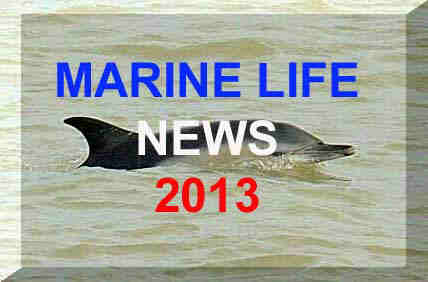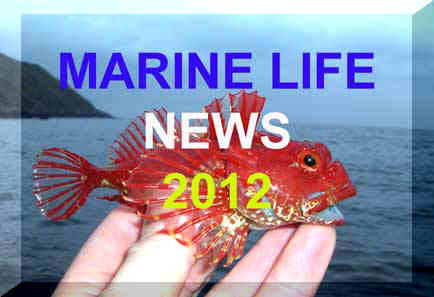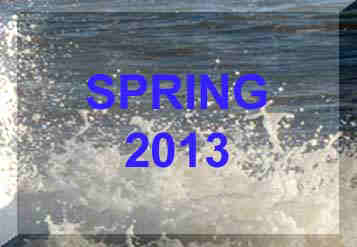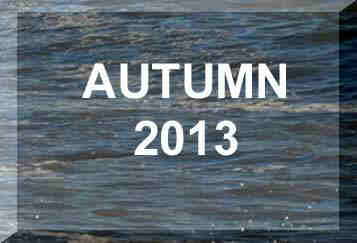LATEST
NEWS:
26
September 2013
A
three metres long 234 kg (515 lb) Bluefin Tuna Thunnus
thynnus was landed caught and landed at Tarbert,
Isle of Harris,
Outer
Hebrides, Scotland.
25
September 2013
A
large pod of Bluefin Tuna Thunnus
thynnus were spotted off the coast of Donegal,
Ireland. There have been numerous reports of big fish jumping out of the
water. One was caught by an angler and brought into Mullaghmore,
County
Sligo. This specimen weighed a massive 285 kg (628 lb).
The
Western Atlantic stock of Bluefin Tuna
is on the Red List as
critically
endangered. It is illegal to catch and land this species of fish in
the UK. (It was landed in Ireland.)
19
September 2013
A
rarely caught Skipjack Tuna, Katsuwonus
pelamis
(=Euthynnus), in English seas was accidentally
stranded on a Devon beach near Budleigh
Salterton. Leo Curtis and friend Ian Carrott
had been fishing on the beach when they spotted the 60 cm long fish in
15 cm of water in the River
Otter estuary. Skipjack are
the smallest and most common of all the
tunnies
but they are native to tropical seas. This is the first record on the BMLSS
News Pages.
"There
have been angling catches of the south-west coast of Ireland and stranding
reports on Scottish western island shores in the past."
BMLSS
Tunnies
18
September 2013
A
rare female Sowerby's
Beaked Whale, Mesoplodon bidens,
a mother with its calf, has died after it got into difficulty, on the remote
shores of Hirta island
in the St Kilda
archipelago. Rescuers managed to refloat the five metre long whale, but
it later died. The calf found open water but it is unlikely to survive
without its mother. This oceanic whale is
rarely seen in British seas and strandings only occur in the extreme west
near deep water.
14
September 2013
A Sei
Whale, Balaenoptera
borealis, suffered a horrible death
after it was washed up alive on the sandy beach at at Waterfoot
Pier, north-east County
Antrim, south-east of Ballycastle,
Northern
Ireland. It was about nine metres in length so that indicated a sub-adult.
Beached
Sei Whale
Photographs
& Report
by Cathal McNaughton
Colour
is spot on for a Sei
Whale, dark leaden grey; fin had a very pale
right side to the throat and this pattern is asymmetrical as is the colour
of the baleen which
looks evenly coloured here; the erect and 'shark-like' dorsal fin is classic,
the Fin Whale
tends to be much more swept back and streamlined looking.
BMLSS
Cetaceans
13
September 2013
Leatherback
Turtles,
Dermochelys
coriacea,
have been spotted off the south Cornish coast, notably a reported two metre
long specimen in Falmouth
Bay.
Cornish
Leatherback Turtles
The
Leatherback
Turtle is the largest of the turtles (Chelonii).
Adults can attain over 1.8 metres (6 ft) in length and 680 kg (1,500 lb)
in weight, but they are usually smaller. Leatherback
Turtles breed
on sandy beaches in the tropics but they are great travellers and can be
found in the temperate and tropical oceans throughout the world where they
feed almost exclusively on jellyfishes
and gelatinous
zooplankton (salps,
hydrozoans
etc.) captured with delicate scissor-like
teeth. They can also accidentally consume floating plastic
bags which will probably result in their death. Unlike other turtles
its carapace is not a hard shell (exoskeleton),
but is covered by a layer of rubbery skin strengthened by bony bits which
makes it look leathery. The turtle discovered in Falmouth Bay probably
swam across the Atlantic Ocean from a breeding site in Florida
or elsewhere in the Caribbean.
The
IUCN
classifies the Leatherback Turtle,
Dermochelys
coriacea, on the Red
List as
critically
endangered.
IUCN
Red Listing
BMLSS
Turtle Reports
12
September 2013
Three
True’s Beaked Whales, Mesolpodon
mirus, were spotted around 100 km
off the southwest coast of Ireland.
The
Irish
Whale and Dolphin Group has said photographs taken during a research
expedition to the Porcupine
Seabight area showed that they were almost certainly this rarely recorded
species classified as a vagrant oceanic whale around the British Isles.
Sighting
records of this whale
are only from off the west coast of Ireland and the Scottish islands. A
Leatherback
Turtle,
Dermochelys
coriacea, was also spotted on the
of the eastern edge of the Porcupine Bight, which includes the Belgica
Mound Special Area of Conservation (SAC) for deep water corals.
BMLSS
Cetaceans
Early
September 2013
A
most extraordinary report of a Striped
Bass, Morone
saxatilis, was caught on rod and line
off Dover Breakwater,
Kent. This is an unusual report because this
is a coastal anadromous
fish native to the east American coast.
Introductions
of Morone saxatilis
5
- 6 September 2013
A
Minke
Whale, Balaenoptera
acutorostrata, stranded alive on Torry
Bay, near Crombie Point, Fife,
in the Firth of
Forth. The rescue attempts to save the four metre long juvenile whale
were unsuccessful and the whale was euthanised.
23
August 2013
A
Swordfish,
Xiphias
gladius, swam
up the River
Tyne and was caught in salmon nets close
to South Tyneside.
The oceanic fish measured 1.2 metres (4 ft) long from the tip of its sword
to its tail.
They
are often called a Broad-billed Swordfish,
but there is only one species in the world. They are found throughout
the tropical and temperate waters of the world but appear to prefer sea
temperatures of 18°C to 22°C,
migrating to cooler waters to feed in the summer. These oceanic fish
chase herring, salmon and mackerel and are among
the fastest fish reaching 90 km.h-1 (56 mph). The Swordfish
is
an extremely rare visitor to the seas around the British Isles with records
of less than one a year. The Atlantic
population is endangered by overfishing.
Previous
Report 2009
BMLSS
Swordfish
2 August
2013
An
Atlantic Sturgeon,
Acipenser
oxyrinchus, was caught on rod and
line off Hobbs
Point, Pembroke
Dock, Pembrokeshire. It was about a metre long.
I query
the identification of this fish and this may be an escaped captive Sturgeon
of another species.
The
Atlantic
Sturgeon,
Acipenser oxyrinchus,
was thought to be extirpated throughout its European range including the
Baltic
Sea and now only found on the American
side of the Atlantic where it is Near
Threatened.
IUCN
Red Listing
The
European
Sturgeon,
Acipenser
sturio,
is now extremely rare throughout its range. The
only remaining breeding population is now in the River
Gironde (France). In the past the Sturgeon
was widespread in the estuaries of the major rivers of northern Europe
including the Rhine,
Elbe,
and the River
Severn.
The
IUCN
classifies the European Sturgeon,
Acipenser
sturio, on the Red List as
critically
endangered. It is a protected species listed in Appendix II of the
Bern
Convention (Convention
on the Conservation of European Wildlife and Natural Habitats),
and its trade is restricted under CITES
Appendix
II.
It
is completely protected in Europe as it is listed in Habitats, Fauna and
Flora (Appendices
II and IV)
of the Bern Convention.
European
Sturgeon (CNPMEM)
Life
story information and status of the European Sturgeon
Previous
Report 2004
BMLSS
Sturgeon 1
BMLSS
Sturgeon 2
IUCN
Red Listing
30
July 2013
A
'super-pod' of at least five hundred White-sided
Dolphins, Lagenorhyncus acutus,
was seen heading north along the west coast of Unst,
Shetland
Isles, late in the morning.
BMLSS
Cetaceans
29
July 2013
A
13.5 metres long Sperm Whale, Physeter
macrocephalus,
was stranded alive on Terschelling,
a northern island in the Netherlands. Unfortunately, despite rescue attempts
the young adult died on the vast expanse of sand on the shore.
28
July 2013
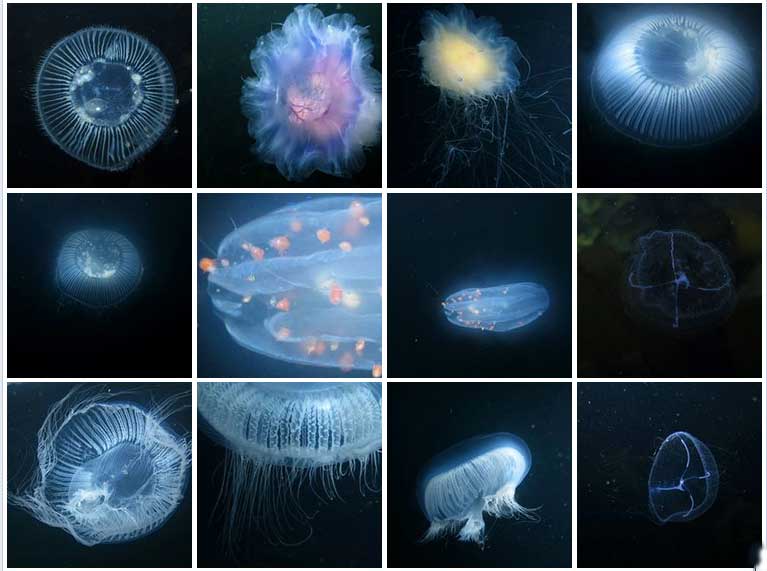
Medusa,
Jellyfish and Comb-jellies
Gallery
by Penny Martin
on
NE
Atlantic Cnidaria facebook
Click
on montage for more images
A cove
near to Yesnaby, Orkney
Isles, hosted hundred of thousands of Jellyfish, Hydromedusa (Crystal
Jellies), Comb-jellies and long strings of Salps.
More
Images and Links
Reports
on Snorkel
Orkney facebook
Photograph
Gallery by Penny Martin
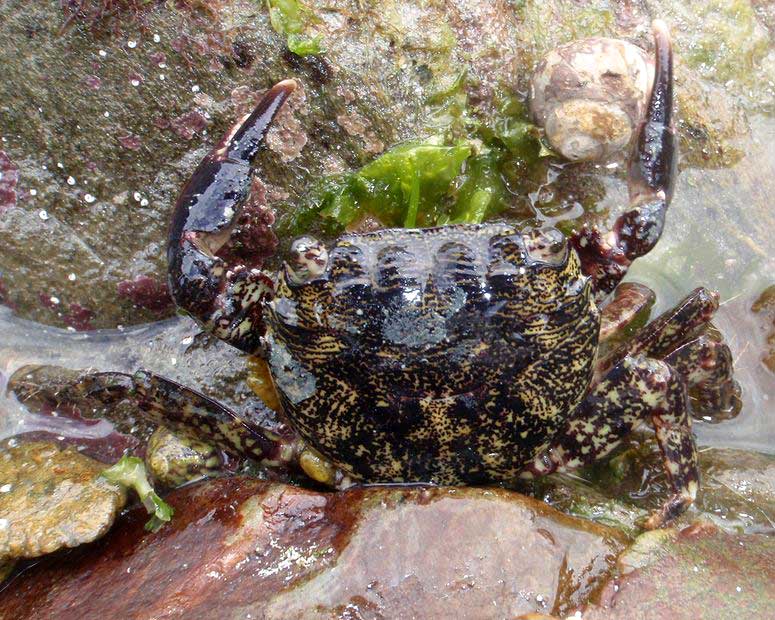
Marbled
Rock Crab, Pachygrapsus
marmoratus
Photograph
by Sion Roberts
28
July 2013
This
appears to be the first record of this immigrant alien crab on the Welsh
shore and only the fourth record around the British Isles.
The
Marbled
Rock Crab is native to the shores of Black
Sea, the Mediterranean Sea and parts of the Atlantic Ocean. It
probably arrived in ballast water as larva or attached to a boat or ship
as an adult.
GB
Non-native Species Secretariat
Late
July 2013
Five
newly born calves of the
Risso’s Dolphin, Grampus
griseus, with their parents, were
spotted off the Calf
of Man,
Isle of
Man.
18
July 2013
 A
large streamlined Shortfin
Mako Shark,
Isurus oxyrinchus,
was hooked by Andy Griffith
30 miles off Milford
Haven, SW Wales. This dangerous shark leapt three metres into the air
off the stern of the boat before Andy
with the help of his crew mates managed to land the two metres long shark
after a fight lasting 40 minutes. Great care was taken to ensure the safety
of angler and crew as large specimens of this shark have been identified
in fatal attacks on humans. The 90 kg
shark was landed and then released. This is
the first record off the Welsh coast.
A
large streamlined Shortfin
Mako Shark,
Isurus oxyrinchus,
was hooked by Andy Griffith
30 miles off Milford
Haven, SW Wales. This dangerous shark leapt three metres into the air
off the stern of the boat before Andy
with the help of his crew mates managed to land the two metres long shark
after a fight lasting 40 minutes. Great care was taken to ensure the safety
of angler and crew as large specimens of this shark have been identified
in fatal attacks on humans. The 90 kg
shark was landed and then released. This is
the first record off the Welsh coast.
(NB:
this fish is very similar to the more often encountered Porbeagle
Shark,
Lamna
nasus. The ID is usually confirmed
by the teeth.)
BMLSS
Sharks
BMLSS
Shark News
July
2013
A
huge Atlantic Halibut, Hippoglossus
hippoglossus, was caught by Marco
Liebenow in northern Norway. It weighed 233
kg (515 lb) and measured 260 cm in length.
BMLSS
Halibut
12
July 2013
A
pod of fifteen (14 adults and one juvenile) Risso’s
Dolphins, Grampus
griseus, was an unprecedented sighting
in such large numbers one mile off the coast of the Isle
of Man. The pod, which consisted of several large males, was spotted
near The Sound off
the south coast by scientists on a boat of the Manx
Basking Shark Watch (MBSW). These
large dolphins are a deeper water species that are rarely seen and can
be identified by scarring on their bodies.
BBC
Cetaceans
Whales
& Dolphins in British Seas (by Steve Savage)
4 July
2013
The
Bearded
Seal,
Erignathus
barbatus, was still showing off at Yell
in the Shetland Isles.
First
Report
3 July
2013
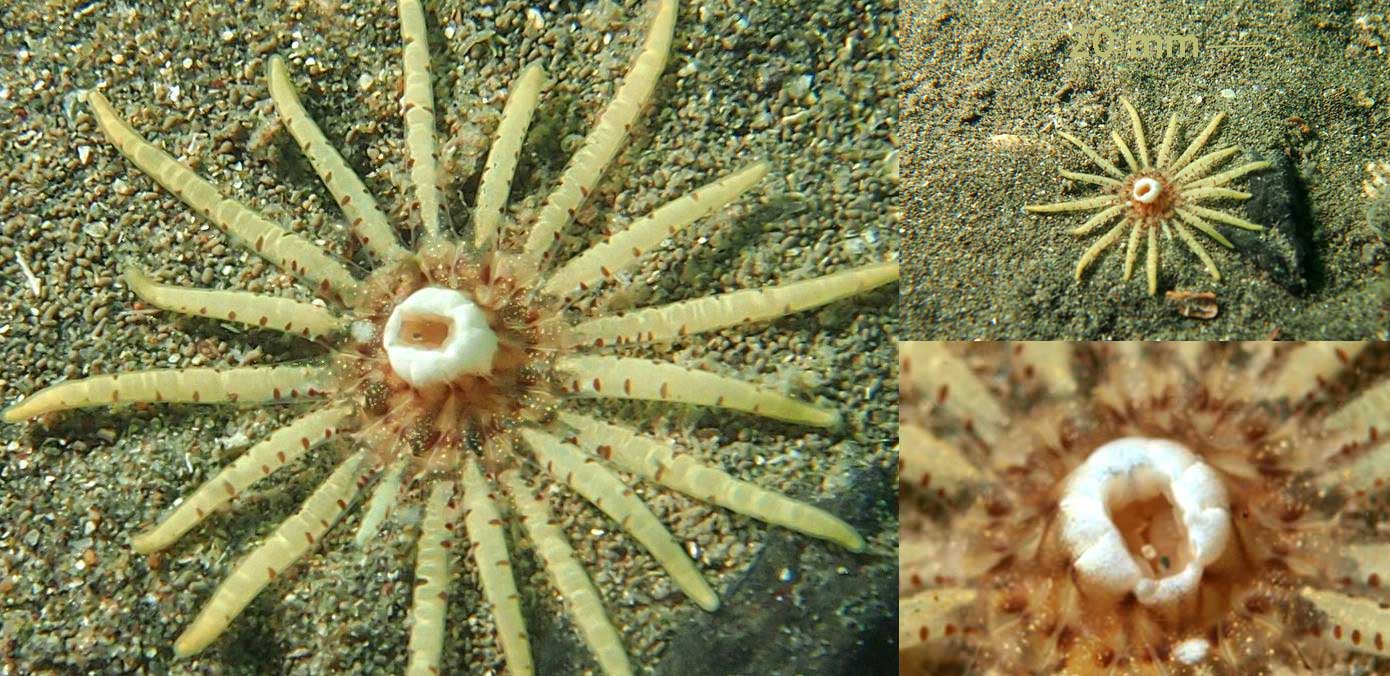
Unidentified
Sea Anemone
Photograph
by Dawn Watson
This
unusual burrowing sea anemone was discovered
with its 20 mm span of tentacles showing
above the substrate of gravel and silt at a depth of about seven metres
at Martins Haven,
Pembrokeshire,
south-west Wales. It was a lone 18 tentacled specimen amongst a mixture
of Peachia
cylindrica Burrowing
Anemones and Daisy
Anemones, Cereus pedunculatus.
When disturbed this unrecognised anemone retracted very quickly and disappeared
completely from view. The majority identification opinion was a burrowing
anemone of the genus Edwardsia.
British
Marine Life News 2011

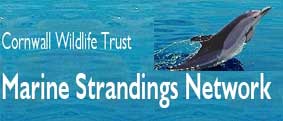
BMLSS
Oil Disasters page


